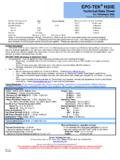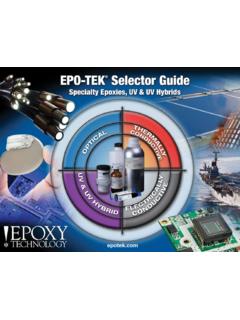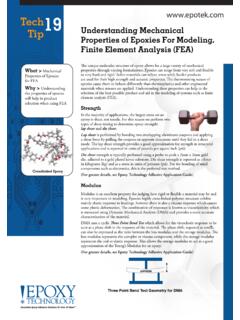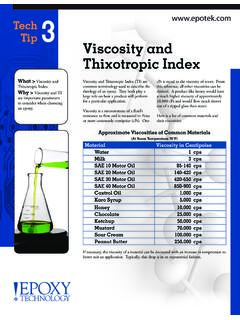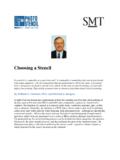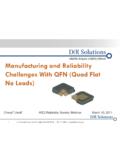Transcription of Tech 20 Tip B-stage Epoxy - Home - Epoxy …
1 TipB- stage Epoxy20 DefinitionB-staged Epoxy resin is a descriptive term used to define a one component Epoxy system, using a latent (low reactivity) curing agent. This unique product can be partially cured (sometimes referred to as pre-dried ), as an initial stage after being applied onto one substrate/surface. It can, at a later time, be completely cured under heat and pressure. This is significantly different from a typical A- stage Epoxy system that is provided in a one or two component format and, is cured in one step at ambient or elevated temperatures. Wh y is B-stage Important?Partially cured Epoxy , or B-staged Epoxy adhesive, does have processing advantages. The adhesive can have its initial application and partial cure in one location, and its final cure in another location days later. In short, B-stage epoxies are typically considered and ultimately chosen for process assembly reasons, rather then technical or performance y Consider B-stage Process? Mass production; apply Epoxy on one day, adhere the parts together at a later date Facility; apply Epoxy at one location, drop ship them to 2nd location for final assembly Service/Value-Added Provider; subcontractors, or electronic packaging companies can apply Epoxy in mass production, then ship pre-applied Epoxy resin parts to their customers Avoiding manufacturing bottlenecks.
2 Increases production capacity because bonding of parts does not have to immediately follow deposition of the Epoxy adhesiveApplications of B-stage Epoxy Adh esives Hybrid Microelectronics Adhering lids over air-cavity / hermetic packages Adhering substrates into package housing Semiconductor Packaging Flip chip processes - flip chip on board, on glass, in package Wafer passivation enabling 3D stacking, wafer back side adhesive Optical Gasket and perimeter sealing of glasses in LCDs / Flat Panel Displays (FPDs) Window mounting in opto-sensors Fiber optic bonding in ferrules PCB level Pre-appling Epoxy on heat sinks Available Formats of B-stage Epoxy Adh esivesB- stage epoxies are available in various forms including liquids and pastes. Most pastes can be easily patterned directly onto the electronic parts, comparable to diced films and at > Understanding B-stage Epoxy AdhesivesWh y > B-staged Epoxy provides many processing advantages in mass production Epoxy Technology Inc.
3 14 Fortune Drive Billerica, MA 01821phone 978-667-3805 fax 978-663-9782 Toll Free 800-227-2201 Epoxy Technology Inc. 2012 DISCLAIMER: Data presented is provided only to be used as a guide. Properties listed are typical, average values, based on tests believed to be accurate. It is recommended that users perform a thorough evaluation for any application based on their specific requirements. Epoxy Technology makes no warranties (expressed or implied) and assumes no responsibility in connection with the use or inability to use these other useful tips, contact our Tech Service Group: or Meth od for B-stage EpoxyLiquid B-stage Epoxy can be applied by hand processes, dip, roller and spray coating. Paste B-stage Epoxy is typically screen, stencil or pad printed and can even approach ultra-fine pitch resolution as seen in figure 1. Single chip photo from a 25 x 25 chip array across an 8 inch wafer. Picture of 5mm x 5mm sensor window screen printed with 200um gasket seal of EPO-TEK B9021-13, at 150 um pitch from its neighborGeneral Considerations of B-stage Epoxies: The Epoxy is typically applied onto one surface only.
4 Its appearance is similar to a tape style adhesive in the form of a dried layer with some surface tack; without a plastic carrier material. Once it is joined to the 2nd surface, with final A- stage curing, it looks like any normal adhesive joint. There is no general rule, but a user should always be careful of over-drying the adhesive, as the surface will lose its tackiness, thus make wetting to the 2nd surface more difficult. Individuals should consult the respective product data sheets for suggested drying : Thickness is controlled by the users processes and design specifications. Normally, the wet layer does not exceed 200-250um. After the drying process, the adhesive layer is typically greater than 10um and less than 150-200um. The Epoxy thickness will be reduced by applying force to the parts during final cure. An A- stage curing process includes mounting and bonding force during the cure. For example, in an LCD gasket sealing process, a 9um dried layer is reduced to a 6um A- stage final cured layer.
5 Handling: It is recommended that pre-applied adhesive on electrical /optical parts be protected from shipping materials, via waffle or gel-pack style trays. Any potentially contaminated B-stage dried adhesive layer may add to the risk of reduced final bond strength and Processing Recommendations: Recommended pressure or force during the A- stage cure can also vary. For example, a 5mm x 5mm optical sensor window shown in Figure 1, 15N pressure at 150 C for 15 sec was realized during the mounting process. Not only does it make acceptable fillets, but it also forces the wetting process. These parts were later post-cured in gang assembly, via off-line process at 150 C for 30 minutes. B-stage Product Line From Epoxy Tech nologyCategoryProductApplication/Comment sOpticalB9021-14 LCD gasket sealing, sensor window sealing non optical beamMA-5 Fiber optic connectors, fiber-ferrule gluingThermalB9021-13 PCB heat sinking, PCB structural assembly, fast dryingB9021-15 PCB heat sinking, PCB structural assembly, slow dryingGeneralB9021-1 Hybrid package lid sealingM10-DVery thixotropic paste, lid sealing hybrids, optical window-attachSilver filledEE149-6 Hybrid packaging, semiconductor flip chipP1011-SPolyimide chemistry, quartz crystal oscillator, stamping processP1011 More viscous version of P1011-S, dispensing processP1011-TMore thixotropic version of P1011, stencil/screen printing process


